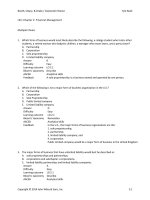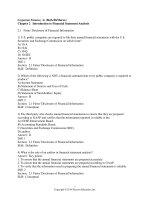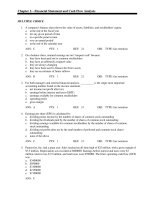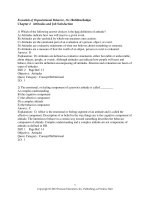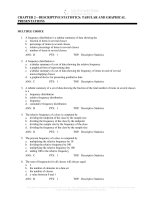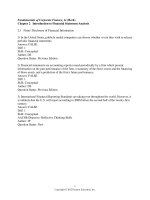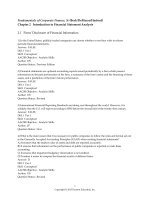Fundamentals of corporate finance 11th edition ross test bank
Bạn đang xem bản rút gọn của tài liệu. Xem và tải ngay bản đầy đủ của tài liệu tại đây (962.06 KB, 84 trang )
Chapter 02 Test Bank - Static
Student: ___________________________________________________________________________
1.
Which one of the following is the financial statement that shows the accounting value of a firm's equity as of a particular date?
A. Income statement.
B. Creditor's statement.
C. Balance sheet.
D. Statement of cash flows.
E. Dividend statement.
2.
Net working capital is defined as:
A. Total liabilities minus shareholders' equity.
B. Current liabilities minus shareholders' equity.
C. Fixed assets minus long-term liabilities.
D. Total assets minus total liabilities.
E. Current assets minus current liabilities.
3.
Which one of these sets forth the common set of standards and procedures by which audited financial statements are prepared?
A.
B.
The Matching Principle.
The Cash Flow Identity.
C.
D.
Generally Accepted Accounting Principles.
Financial Accounting Reporting Principles.
E.
Standard Accounting Value Guidelines.
1
4.
Which one of the following is the financial statement that summarizes a firm's revenue and expenses over a period of time?
A.
B.
C.
D.
Income statement.
Balance sheet.
Statement of cash flows.
Tax reconciliation statement.
E.
5.
Market value report.
Noncash items refer to:
A. Accrued expenses.
B. Inventory items purchased using credit.
C. The ownership of intangible assets such as patents.
D. Expenses which do not directly affect cash flows.
E. Sales which are made using store credit.
6.
The percentage of the next dollar you earn that must be paid in taxes is referred to as the _____ tax rate.
A.
B.
Mean.
Residual.
C. Total.
D. Average.
E. Marginal.
2
7.
The _____ tax rate is equal to total taxes divided by total taxable income.
A.
Deductible.
B.
Residual.
C.
Total.
D. Average.
E. Marginal.
8.
The cash flow of a firm that is available for distribution to the firm's creditors and stockholders is called the:
A. Operating cash flow.
B. Net capital spending.
C. Net working capital.
D. Cash flow from assets.
E. Cash flow to stockholders.
9.
Which term relates to the cash flow that results from a firm's ongoing, normal business activities?
A.
B.
Operating cash flow.
Capital spending.
C.
Net working capital.
D. Cash flow from assets.
E. Cash flow to creditors.
3
10.
Cash flow from assets is also known as the firm's:
A. Capital structure.
B. Equity structure.
C. Hidden cash flow.
D. Free cash flow.
E. Historical cash flow.
11.
The cash flow related to interest payments less any net new borrowing is called the:
A. Operating cash flow.
B. Capital spending cash flow.
C. Net working capital.
D. Cash flow from assets.
E. Cash flow to creditors.
12.
Cash flow to stockholders is defined as:
A. The total amount of interest and dividends paid during the past year.
B. The change in total equity over the past year.
C. Cash flow from assets plus the cash flow to creditors.
D. Operating cash flow minus the cash flow to creditors.
E. Dividend payments less net new equity raised.
13.
Which one of the following is classified as a tangible fixed asset?
A. Accounts receivable.
B. Production equipment.
C. Cash.
D. Patent.
E. Inventory.
4
14.
Which of the following are current assets?
I. Cash
II. Trademark
III. Accounts receivable
IV. Notes payable
A. II and III only.
B. I and III only.
C. I, II, and IV only.
D. I, II, and IV only.
E. II, III, and IV only.
15.
Which one of the following is included in a firm's market value but yet is excluded from the firm's accounting value?
A.
Real estate investment.
B.
Good reputation of the company.
C.
Equipment owned by the firm.
D.
Money due from a customer.
E.
An item held by the firm for future sale.
5
16.
Which of the following are included in current liabilities?
I. Note payable to a supplier in 13 months.
II. Amount due from a customer last week.
III. Account payable to a supplier that is due next week.
IV. Loan payable to the bank in 10 months.
A.
B.
C.
D.
I and III only.
III and IV only.
I, II, and III only.
I, III, and IV only.
E.
I, II, III, and IV.
17.
Which one of the following will decrease the value of a firm's net working capital?
A. Using cash to pay a supplier.
B. Depreciating an asset.
C. Collecting an accounts receivable.
D. Purchasing inventory on credit.
E. Selling inventory at a loss.
18.
Which one of the following statements concerning net working capital is correct?
A. Net working capital increases when inventory is purchased with cash.
B. Net working capital excludes inventory.
C. Total assets must increase if net working capital increases.
D. Net working capital may be a negative value.
E. Net working capital is the amount of cash a firm currently has available for spending.
19.
Which one of the following statements concerning net working capital is correct?
A. The lower the value of net working capital is, the greater is the ability of a firm to meet its current obligations.
B. An increase in net working capital must also increase current assets.
C. Net working capital increases when inventory is sold for cash at a profit.
D. Firms with equal amounts of net working capital are also equally liquid.
E. Net working capital is a part of the operating cash flow.
6
20.
Which one of the following accounts is the most liquid?
A. Inventory.
B. Building.
C. Accounts Receivable.
D. Equipment.
E. Land.
21.
Which one of the following represents the most liquid asset?
A. $100 account receivable that is discounted and collected for $96 today.
B. $100 of inventory which is sold today on credit for $103.
C. $100 of inventory which is discounted and sold for $97 cash today.
D. $100 of inventory that is sold today for $100 cash.
E. $100 accounts receivable that will be collected in full next week.
22.
Which one of the following statements related to liquidity is correct?
A. Liquid assets tend to earn a high rate of return.
B. Liquid assets are valuable to a firm.
C. Liquid assets are defined as assets that can be sold quickly regardless of the price obtained.
D. Inventory is more liquid than accounts receivable because inventory is tangible.
E. Any asset that can be sold is considered liquid.
23.
Shareholders' equity:
A.
B.
C.
D.
E.
Is referred to as a firm’s financial leverage.
Is equal to total assets plus total liabilities.
Decreases whenever new shares of stock are issued.
Includes patents, preferred stock, and common stock.
Represents the residual value of a firm.
7
24.
The higher the degree of financial leverage employed by a firm is, the:
A. Higher is the probability that the firm will encounter financial distress.
B. Lower is the amount of debt incurred.
C. Less debt a firm has per dollar of total assets.
D. Higher is the number of outstanding shares of stock.
E. Lower is the balance in accounts payable.
25.
The book value of a firm is:
A. Equivalent to the firm's market value provided that the firm has some fixed assets.
B. Based on historical cost.
C. Generally greater than the market value when fixed assets are included.
D. More of a financial than an accounting valuation.
E. Adjusted to the market value whenever the market value exceeds the stated book value.
26.
Which of the following is (are) included in the market value of a firm but is (are) excluded from the firm's book value?
I. Value of management skills.
II. Value of a copyright.
III. Value of the firm's reputation.
IV. Value of employee's experience.
A. I only.
B. II only.
C. III and IV only.
D. I, II, and III only.
E. I, III, and IV only.
27.
You recently purchased a grocery store. At the time of the purchase, the store's market value equaled its book value. The purchase included
the building, the fixtures, and the inventory. Which one of the following is most apt to cause the market value of this store to be lower than
the book value?
A. A sudden and unexpected increase in inflation.
B. The replacement of old inventory items with more desirable products.
C. Improvements to the surrounding area by other store owners.
D. Construction of a new restricted access highway located between the store and the surrounding residential areas.
E. Addition of a stop light at the main entrance to the store's parking lot.
8
28.
Which one of the following is true according to generally accepted accounting principles?
A. Depreciation is recorded based on the market value principle.
B. Income is recorded based on the realization principle.
C. Costs are recorded based on the realization principle.
D. Depreciation is recorded based on the recognition principle.
E. Costs of goods sold are recorded based on the matching principle.
29.
Which one of these is most apt to be a fixed cost?
A.
Raw materials.
B.
Manufacturing wages.
C.
Management bonuses.
D.
Office salaries.
E.
Shipping and freight.
9
30.
Which of the following are expenses for accounting purposes but are not operating cash flows for financial purposes?
I. Interest expense.
II. Taxes.
III. Cost of goods sold.
IV. Depreciation.
A.
IV only.
B.
II and IV only.
C.
I and III only.
D.
I and IV only.
E.
I, II, and IV only.
31.
Which one of the following statements related to an income statement is correct? Assume accrual accounting is used.
A. The addition to retained earnings is equal to net income plus dividends paid.
B. Credit sales are recorded on the income statement when the cash from the sale is collected.
C. The labor costs for producing a product are expensed when the product is sold.
D. Interest is a non-cash expense.
E. Depreciation increases the marginal tax rate.
32.
Which one of the following statements related to taxes is correct?
A. The marginal tax rate must be equal to or lower than the average tax rate for a firm.
B. The tax for a firm is computed by multiplying the firm's current marginal tax rate times the taxable income.
C. Additional income is taxed at a firm's average tax rate.
D. Given the tax structure in 2014, the highest average corporate tax rate is 34 percent.
E. The marginal tax rate for a firm can be either higher than or the same as the average tax rate.
10
33.
As of 2015, which one of the following statements concerning corporate income taxes is correct?
A. The largest corporations have an average tax rate of 39 percent.
B. The lowest marginal rate is 25 percent.
C. A firm's tax is computed on an incremental basis.
D. A firm's marginal tax rate will generally be lower than its average tax rate once the firm's income exceeds $50,000.
E. When analyzing a new project, the average tax rate should be used.
34.
Depreciation for a tax-paying firm:
A.
B.
C.
Increases expenses and lowers taxes.
Increases the net fixed assets as shown on the balance sheet.
Reduces both the net fixed assets and the costs of a firm.
D. Is a noncash expense that increases the net income.
E. Decreases net fixed assets, net income, and operating cash flows.
35.
Which one of the following statements related to an income statement is correct?
A. Interest expense increases the amount of tax due.
B. Depreciation does not affect taxes since it is a non-cash expense.
C. Net income is distributed to dividends and paid-in surplus.
D. Taxes reduce both net income and operating cash flow.
E. Interest expense is included in operating cash flow.
36.
Which one of the following statements is correct concerning a corporation with taxable income of $125,000?
A. Net income minus dividends paid will equal the ending retained earnings for the year.
B. An increase in depreciation will increase the operating cash flow.
C. Net income divided by the number of shares outstanding will equal the dividends per share.
D. Interest paid will be included in both net income and operating cash flow.
E. An increase in the tax rate will increase both net income and operating cash flow.
11
37.
Which one of the following will increase the cash flow from assets, all else equal?
A. Decrease in cash flow to stockholders.
B. Decrease in operating cash flow.
C. Decrease in the change in net working capital.
D. Decrease in cash flow to creditors.
E. Increase in net capital spending.
38.
For a tax-paying firm, an increase in _____ will cause the cash flow from assets to increase.
A.
Depreciation.
B.
Net capital spending.
C.
Change in net working capital.
D.
Taxes.
E.
Production costs.
39.
Which one of the following must be true if a firm had a negative cash flow from assets?
A. The firm borrowed money.
B. The firm acquired new fixed assets.
C. The firm had a net loss for the period.
D. The firm utilized outside funding.
E. Newly issued shares of stock were sold.
12
40.
An increase in the depreciation expense will do which of the following for a firm with taxable income of $80,000?
I. Increase net income.
II. Decrease net income.
III. Increase the cash flow from assets.
IV. Decrease the cash flow from assets.
A.
B.
I only.
II only.
C. I and III only.
D. II and III only.
E. II and IV only.
41.
Which one of the following is NOT included in cash flow from assets?
A. Accounts payable.
B. Inventory.
C. Sales.
D. Interest expense.
E. Cash account.
42.
Net capital spending:
A.
B.
C.
Is equal to ending net fixed assets minus beginning net fixed assets.
Is equal to zero if the decrease in the net fixed assets is equal to the depreciation expense.
Reflects the net changes in total assets over a stated period of time.
D. Is equivalent to the cash flow from assets minus the operating cash flow minus the change in net working capital.
E. Is equal to the net change in the current accounts.
43.
Which one of the following statements related to the cash flow to creditors is correct?
A. If the cash flow to creditors is positive, then the firm must have borrowed more money than it repaid.
B. If the cash flow to creditors is negative, then the firm must have a negative cash flow from assets.
C. A positive cash flow to creditors represents a net cash outflow from the firm.
D. A positive cash flow to creditors means that a firm has increased its long-term debt.
E. If the cash flow to creditors is zero, then a firm has no long-term debt.
13
44.
A positive cash flow to stockholders indicates which one of the following with certainty?
A. The dividends paid exceeded the net new equity raised.
B. The amount of the sale of common stock exceeded the amount of dividends paid.
C. No dividends were distributed, but new shares of stock were sold.
D. Both the cash flow to assets and the cash flow to creditors must be negative.
E. Both the cash flow to assets and the cash flow to creditors must be positive.
45.
A firm has $680 in inventory, $2,140 in fixed assets, $210 in accounts receivables, $250 in accounts payable, and $80 in cash. What is the
amount of the net working capital?
A. $970
B. $720
C. $640
D. $3,110
E. $2,860
46.
A firm has net working capital of $560. Long-term debt is $3,970, total assets are $7,390, and fixed assets are $3,910. What is the amount of
the total liabilities?
A. $2,050
B. $2,920
C. $4,130
D. $7,950
E. $6,890
47.
A firm has common stock of $6,200, paid-in surplus of $9,100, total liabilities of $8,400, current assets of $5,900, and fixed assets of
$21,200. What is the amount of the shareholders' equity?
A. $6,900
B. $15,300
C. $18,700
D. $23,700
E. $35,500
14
48.
Your firm has total assets of $4,900, fixed assets of $3,200, long-term debt of $2,900, and short-term debt of $1,400. What is the amount of
net working capital?
A. -$100
B. $300
C. $600
D. $1,700
E. $1,800
49.
Bonner Automotive has shareholders' equity of $218,700. The firm owes a total of $141,000 of which 40 percent is payable within the next
year. The firm has net fixed assets of $209,800. What is the amount of the net working capital?
A. $149,900
B. $93,500
C. $125,600
D. -$47,500
E. $56,500
50.
Four years ago, Ship Express purchased a mailing machine at a cost of $218,000. This equipment is currently valued at $97,400 on today's
balance sheet but could actually be sold for $92,900. This is the only fixed asset the firm owns. Net working capital is $41,300 and longterm debt is $102,800. What is the book value of shareholders' equity?
A. $31,400
B. $47,700
C. $35,900
D. $249,400
E. $253,900
51.
Drew owns The What-Not Shop, which he is trying to sell so that he can retire and travel. The shop owns the building in which it is located.
This building was built at a cost of $647,000 and is currently appraised at $819,000. The counters and fixtures originally cost $148,000 and
are currently valued at $65,000. The inventory is valued on the balance sheet at $319,000 and has a retail market value equal to 1.1 times its
cost. Jake expects the store to collect 96 percent of the $21,700 in accounts receivable. The firm has $26,800 in cash and has total debt of
$414,700. What is the market value of this firm?
A. $867,832
B. $900,166
C. $695,832
D. $775,632
E. $1,190,332
15
52.
Jensen Enterprises paid $1,300 in dividends and $920 in interest this past year. Common stock increased by $1,200 and retained earnings
decreased by $310. What is the net income for the year?
A. -$210
B. $990
C. $1,610
D. $1,910
E. $2,190
53.
Andre's Bakery has sales of $613,000 with costs of $479,000. Interest expense is $26,000 and depreciation is $42,000. The tax rate is 25
percent. What is the net income?
A.
B.
$42,750
$49,500
C. $39,000
D. $81,000
E. $74,550
54.
Kaylor Equipment Rental paid $75 in dividends and $511 in interest expense. The addition to retained earnings is $418 and net new equity is
$500. The tax rate is 35 percent. Sales are $15,900 and depreciation is $680. What are the earnings before interest and taxes?
A. $589.46
B. $1,269.46
C. $1,331.54
D. $9,560.85
E. $10,949.46
16
55.
Given the tax rates as shown, what is the average tax rate for a firm with taxable income of $289,740?
A. 26.68 percent
B. 35.87 percent
C. 33.22 percent
D. 34.67percent
E. 39.00 percent
56.
The tax rates are as shown. Nevada Mining currently has taxable income of $97,800. How much additional tax will the firm owe if taxable
income increases by $21,000?
A. $8,080
B. $8,130
C. $8,155
D. $8,170
E. $8,190
57.
Winston Industries had sales of $843,800 and costs of $609,900. The firm paid $38,200 in interest and $18,000 in dividends. It also
increased retained earnings by $62,138 for the year. The depreciation was $76,400. What is the average tax rate?
A. 32.83 percent
B. 33.33 percent
C. 38.17 percent
D. 43.39 percent
E. 48.87 percent
17
58.
RTF Oil has total sales of $911,400 and costs of $787,300. Depreciation is $52,600 and the tax rate is 34 percent. The firm does not have
any interest expense. What is the operating cash flow?
A. $148,410
B. $68,320
C. $79,924
D. $81,417
E. $99,790
59.
Nielsen Auto Parts had beginning net fixed assets of $218,470 and ending net fixed assets of $209,411. During the year, assets with a
combined book value of $6,943 were sold. Depreciation for the year was $42,822. What is the amount of net capital spending?
A. $33,763
B. $40,706
C. $58,218
D. $65,161
E. $67,408
60.
At the beginning of the year, a firm had current assets of $121,306 and current liabilities of $124,509. At the end of the year, the current
assets were $122,418 and the current liabilities were $103,718. What is the change in net working capital?
A. -$19,679
B. -$11,503
C. -$9,387
D. $1,809
E. $21,903
61.
At the beginning of the year, the long-term debt of a firm was $72,918 and total debt was $138,407. At the end of the year, long-term debt
was $68,219 and total debt was $145,838. The interest paid was $6,430. What is the amount of the cash flow to creditors?
A. $1,731
B. -$1,001
C. $11,129
D. $13,861
E. $19,172
18
62.
Ernie’s Home Repair had beginning long-term debt of $51,207 and ending long-term debt of $36,714. The beginning and ending total debt
balances were $59,513 and $42,612, respectively. The interest paid was $2,808. What is the amount of the cash flow to creditors?
A. -$11,685
B. -$11,272
C. $17,301
D. $17,418
E. $11,174
63.
The Daily News had net income of $121,600 of which 40 percent was distributed to the shareholders as dividends. During the year, the
company sold $75,000 worth of common stock. What is the cash flow to stockholders?
A. -$75,000
B. -$26,360
C. -$2,040
D. $123,640
E. $147,960
64.
The Lakeside Inn had operating cash flow of $48,450. Depreciation was $6,700 and interest paid was $2,480. A net total of $2,620 was paid
on long-term debt. The firm spent $24,000 on fixed assets and decreased net working capital by $1,330. What is the amount of the cash flow
to stockholders?
A. $5,100
B. $7,830
C. $18,020
D. $19,998
E. $20,680
19
65.
The following information pertains to Galaxy Interiors:
What is the net capital spending for 2015?
A. -$382
B. $1,229
C. -$127
D. $1,993
E. $1,172
20
66.
The following information pertains to Galaxy Interiors:
What is the amount of the noncash expenses for 2015?
A. $740
B. $1,282
C. $1,333
D. $1,611
E. $2,351
21
67.
The following information pertains to Galaxy Interiors:
What is the cash flow to creditors for 2015?
A. -$530
B. $432
C. $1,839
D. 2,132
E. $3,094
22
68.
The following information pertains to Galaxy Interiors:
What is the operating cash flow for 2015?
A. $2,114
B. $2,900
C. $2,985
D. $3,536
E. $4,267
23
69.
The following information pertains to Galaxy Interiors:
What is the free cash flow for 2015?
A. $1,732
B. $2,247
C. $2,961
D. $3,915
E. $4,267
24
70.
The following information pertains to Galaxy Interiors:
What is the amount of dividends paid for 2015?
A. $0
B. $1,948
C. $1,374
D. 800
E. $574
25
